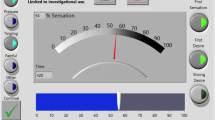Abstract
Urgency, the primary symptom of overactive bladder (OAB), is thought to be central in driving all other symptoms of OAB, including frequency, nocturia, and urge urinary incontinence. Although it is defined by the International Continence Society as a sudden compelling desire to pass urine that is difficult to defer, it remains difficult to describe and measure. Several self-administered metrics have been developed to measure urgency and have been used to demonstrate the efficacy of antimuscarinic agents in the treatment of OAB. Urodynamics measures bladder sensation during cystometry, but its role in measuring urgency has not been well defined. This review discusses scales commonly used to measure urgency and the role of urodynamics in its assessment.
Similar content being viewed by others
References and Recommended Reading
Abrams P, Cardozo L, Magnus F, et al.: The standardisation of terminology in lower urinary tract function: report from the standardisation sub-committee of the International Continence Society. Urology 2003, 61:37–49.
Stewart WF, Van Rooyen JB, Cundiff GW, et al.: Prevalence and burden of overactive bladder in the United States. World J Urol 2003, 20:327–336.
Abrams P, Kelleher CJ, Kerr LA, Rogers RG: Overactive bladder significantly affects quality of life. Am J Manag Care 2000, 6:S580–S590.
Naoemova I, De Wachter S, Wyndaele JJ: Comparison of sensation-related voiding patterns between continent and incontinent women: a study with 3-day sensationrelated bladder diary (SR-BD). Neurourol Urodyn 2008, 27:511–514.
Cardozo L, Coyne KS, Versi E: Validation of the urgency perception scale. BJU Int 2005, 95:591–596.
Van Kerrebroeck P, Kreder K, Jonas U, et al.: Tolterodine once-daily: superior efficacy and tolerability in the treatment of the overactive bladder. Urology 2001, 57:414–421.
Siami P, Seldman S, Lama D: A multicenter, prospective, open-label of tolterodine extended-release 4 mg for overactive bladder: the speed of onset of therapeutic assessment trial (STAT). Clin Ther 2002, 24:616–628.
Blaivas JG, Panagopoulos G, Weiss JP, et al.: The urgency perception score: validation and test-retest. J Urol 2007, 177:199–202.
Nixon A, Colman S, Sabounjian L, et al.: A validated patient reported measure of urinary urgency severity in overactive bladder for use in clinical trials. J Urol 2005, 174:604–607.
Staskin D, Sand P, Zinner N, Dmochowski R; for the Trospium Study Group: Once daily trospium chloride is effective and well tolerated for the treatment of overactive bladder. Results from a multicenter phase III trial. J Urol 2007, 178:978–984.
Cardozo L, Dixon A: Increased warning time with darifenacin. A new concept in the management of urinary urgency. J Urol 2005, 173:1214–1218.
Staskin DR: The urge to define urgency: a review of three approaches. Curr Urol Rep 2004, 5:413–415.
Karram MM, Toglia MR, Serels SR, et al.: Treatment with solifenacin increases warning time and improves symptoms of overactive bladder: results from VENUS, a randomized, double-blind, placebo-controlled trial. Urology 2009, 73:14–18.
Pfisterer MHD, Griffiths DJ, Rosenberg L, et al.: Parameters of bladder function in pre-, peri-, and postmenopausal women without detrusor overactivity. Neurourol Urodyn 2007, 26:356–361.
Pauwels E, De Wachter S, Wyndaele JJ: Normality in urodynamics studied in healthy adults. J Urol 1999, 161:899–902.
Brostrom S, Jennum P, Lose G: Short-term reproducibility of cystometry and pressure-flow micturition studies in healthy women. Neurourol Urodyn 2002, 21:457–460.
Erdem E, Tunckiran A, Acar D, et al.: Is catheter cause of subjectivity in sensations perceived during cystometry? Urology 2005, 66:1000–1003.
De Wachter S, Van Meel TD, Wyndaele JJ: Can a faked cystometry deceive patients in their perception of filling sensations? A study on the reliability of spontaneous reported cystometric filling sensations in patients with non-neurogenic lower urinary tract dysfunction. Neurourol Urodyn 2008, 27:395–398.
Al-Hayek S, Belal M, Abrams P: Does the patient’s position influence the detection of detrusor overactivity? Neurourol Urodyn 2008, 27:279–286.
Sekido N, Hinotsu S, Kawai K, et al.: How many uncomplicated male and female overactive bladder patients reveal detrusor overactivity during urodynamic study? Int J Urol 2006, 13:1276–1279.
Dompeyre P, Fritel X, Bader G, et al.: Bladder sensitivity testing using a visual analogue scale: comparative cystometric study of women. Neurourol Urodyn 2007, 26:350–355.
Lowenstein L, FitzGerald MP, Kenton K, et al.: Validation of a real-time urodynamic measure of urinary sensation. Am J Obstet Gynecol 2008, 198:661.e1–661.e4.
Chapple CR, MacDiarmid SA, Patel A: Urodynamics Made Easy, edn 3. Edinburgh, United Kingdom: Churchill Livingstone Elsevier; 2009.
Author information
Authors and Affiliations
Corresponding author
Rights and permissions
About this article
Cite this article
MacDiarmid, S.A. Measuring bladder sensation: A clinical and laboratory approach. Curr Bladder Dysfunct Rep 4, 155–159 (2009). https://doi.org/10.1007/s11884-009-0022-2
Published:
Issue Date:
DOI: https://doi.org/10.1007/s11884-009-0022-2




